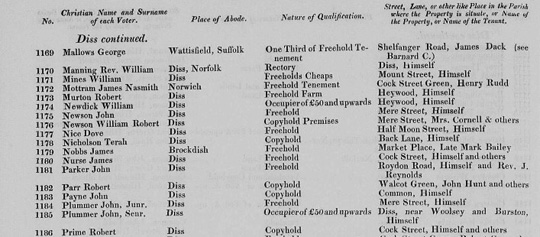Searching Electoral Rolls for Ancestors
| Tweet |
|
An electoral roll (known formally as an electoral register) is a list of people who are eligible to vote in a given jurisdiction. Electoral rolls are valuable to genealogists because they tie the name of an individual to a specific address and time.
A typical historic electoral roll lists the full name of the individual and their address. Some electoral rolls also include additional information such as age, the occupation of the individual and the reason they were eligible to vote. In this article, we discuss the ins and outs of electoral rolls, including where to find this valuable resource online.
Key Aspects of Historic Electoral Rolls
Electoral rolls have several key features that make them appealing to genealogists:
• Electoral rolls have been in existence in many jurisdictions for over 150 years. For example, UK electoral rolls were first introduced in 1832. The first electoral rolls in Australia date to the 1840s. In some jurisdictions (such as the UK), electoral rolls predate census records.
• Electoral rolls were produced by local, state and national governments. In many jurisdictions, electoral rolls were produced on a regular basis, often every year. Thus, electoral rolls can provide a near-continuous record of the inhabitants of a region.
• Electoral rolls can serve as a valuable supplement to 10-year census records. In particular, an electoral roll can be used to trace the address of someone who moved frequently. It can also be used to determine the year when an adult child left the household.
• Electoral rolls can also serve as a powerful proxy to estimate the year of birth and the year of death of an ancestor. This is due to the fact that once an individual reached voting age, they tended to stay on the voting list until they died. To estimate the year of birth, simply determine the first time a person appears on the electoral roll. Counting backwards from this year by the minimum voting age provides a reasonable estimate of the year of birth. Similarly, the year of death can be determined by the last year a person appeared on an electoral roll.

• Electoral rolls were often organized by address, as shown in the example above. This is useful since family members often lived close to one other. For example, two brothers might have lived down the same street from each other. Similarly married family members may have lived close to their parents. If you come across other people with the same surname in the same neighbourhood as your ancestors, it is possible these people were relatives. This is an especially useful tip if you are researching an uncommon surname. If you discover the address of an ancestor, you should consider searching the surrounding area in the electoral roll for other possible relatives.
• To conserve space, many electoral rolls abbreviated first names and addresses. Use our List of First Name Abbreviations and City Directory Abbreviations to assist you when reading these rolls.

